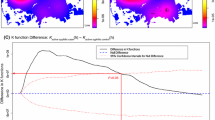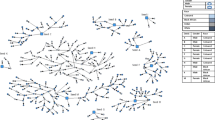Abstract
We assess the geographic coverage and spatial clustering of drug users recruited through respondent-driven sampling (RDS) and discuss the potential for biased RDS prevalence estimates. Illicit drug users aged 18–40 were recruited through RDS (N = 401) and targeted street outreach (TSO) (N = 210) in New York City. Using the Google Maps API™, we calculated travel distances and times using public transportation between each participant’s recruitment location and the study office and between RDS recruiter–recruit pairs. We used K function analysis to evaluate and compare spatial clustering of (1) RDS vs. TSO respondents and (2) RDS seeds vs. RDS peer recruits. All participant recruitment locations clustered around the study office; however, RDS participants were significantly more likely to be recruited within walking distance of the study office than TSO participants. The TSO sample was also less spatially clustered than the RDS sample, which likely reflects (1) the van’s ability to increase the sample’s geographic heterogeneity and (2) that more TSO than RDS participants were enrolled on the van. Among RDS participants, individuals recruited spatially proximal peers, geographic coverage did not increase as recruitment waves progressed, and peer recruits were not less spatially clustered than seeds. Using a mobile van to recruit participants had a greater impact on the geographic coverage and spatial dependence of the TSO than the RDS sample. Future studies should consider and evaluate the impact of the recruitment approach on the geographic/spatial representativeness of the sample and how spatial biases, including the preferential recruitment of proximal peers, could impact the precision and accuracy of estimates.






Similar content being viewed by others
References
Lu X. Respondent-driven sampling: theory, limitations & improvements. Dissertation, Department of Public Health Sciences, Karolinska Institutet, Stockholm, Sweden; 2013.
Gallagher K, Sullivan P, Lansky A, Onorato I. Behavioral surveillance among people at risk for HIV infection in the U.S.: the National HIV Behavioral Surveillance System. Public Health Rep. 2007; 122(Suppl 1): 32–8.
Lansky A, Abdul-Quader AS, Cribbin M, et al. Developing an HIV behavioral surveillance system for injecting drug users: the National HIV Behavioral Surveillance System. Public Health Rep. 2007; 122(Suppl 1): 48.
Heckathorn DD. Respondent-driven sampling: a new approach to the study of hidden populations. Soc Probl. 1997; 174–199.
Watters JK, Biernacki P. Targeted sampling: options for the study of hidden populations. Soc Probs. 1989; 36: 416.
Kral AH, Malekinejad M, Vaudrey J, et al. Comparing respondent-driven sampling and targeted sampling methods of recruiting injection drug users in San Francisco. J Urban Health. 2010; 87(5): 839–50.
Broadhead RS, Heckathorn DD, Weakliem DL, et al. Harnessing peer networks as an instrument for AIDS prevention: results from a peer-driven intervention. Public Health Rep. 1998; 113(Suppl 1): 42.
Heckathorn DD. Respondent-driven sampling II: deriving valid population estimates from chain-referral samples of hidden populations. Soc Probl. 2002; 49(1): 11–34.
Wang J, Carlson RG, Falck RS, Siegal HA, Rahman A, Li L. Respondent-driven sampling to recruit MDMA users: a methodological assessment. Drug Alcohol Depend. 2005; 78(2): 147–57.
Wejnert C. An empirical test of respondent-driven sampling: point estimates, variance, degree measures, and out-of-equilibrium data. Sociol Methodol. 2009; 39(1): 73–116.
Liu H, Li J, Ha T. Assessment of random recruitment assumption in respondent-driven sampling in egocentric network data. Social Networking. 2012; 1(2): 13–21.
McCreesh N, Frost SDW, Seeley J, et al. Evaluation of respondent-driven sampling. Epidemiology. 2012; 23(1): 138.
Rudolph AE, Crawford ND, Latkin C, et al. Subpopulations of illicit drug users reached by targeted street outreach and respondent-driven sampling strategies: implications for research and public health practice. Ann Epidemiol. 2011; 21(4): 280–9.
Heckathorn DD, Semaan S, Broadhead RS, Hughes JJ. Extensions of respondent-driven sampling: a new approach to the study of injection drug users aged 18–25. AIDS Behav. 2002; 6(1): 55–67.
Wejnert C, Heckathorn DD. Web-based network sampling efficiency and efficacy of respondent-driven sampling for online research. Sociol Methods Res. 2008; 37(1): 105–34.
Young AM, Rudolph AE, Quillen D, Havens JR. Spatial, temporal, and relational patterns in respondent driven sampling: evidence from a social network study of rural drug users. Journal of Epidemiology and Community Health. Unpublished.
Wylie JL, Jolly AM. Understanding recruitment: outcomes associated with alternate methods for seed selection in respondent driven sampling. BMC Med Res Methodol. 2013; 13(1): 93.
Burt RD, Hagan H, Sabin K, Thiede H. Evaluating respondent-driven sampling in a major metropolitan area: comparing injection drug users in the 2005 Seattle area national HIV behavioral surveillance system survey with participants in the RAVEN and Kiwi studies. Ann Epidemiol. 2010; 20(2): 159–67.
McCreesh N, Johnston LG, Copas A, et al. Evaluation of the role of location and distance in recruitment in respondent-driven sampling. Int J Health Geogr. 2011; 10(1): 56.
Jenness SM, Neaigus A, Wendel T, Gelpi-Acosta C, Hagan H. Spatial recruitment bias in respondent-driven sampling: implications for HIV prevalence estimation in urban heterosexuals. AIDS Behav. 2013; 1–8.
Toledo L, Codeço CT, Bertoni N, Albuquerque E, Malta M, Bastos FI. Putting respondent-driven sampling on the map: insights from Rio de Janeiro, Brazil. JAIDS J Acquir Immune Defic Syndr. 2011; 57: S136–43.
Qiu P, Yang Y, Ma X, et al. Respondent-driven sampling to recruit in-country migrant workers in China: a methodological assessment. Scand J Publ Health. 2012; 40(1): 92–101.
Abdul‐Quader AS, Heckathorn DD, McKnight C, et al. Effectiveness of respondent-driven sampling for recruiting drug users in New York City: findings from a pilot study. Journal of Urban Health. 2006;83(3):459–476.
AIDSVu. Emory University, Rollins School of Public Health. Available: www.aidsvu.org. Accessed January 20, 2014.
Ompad DC, Galea S, Marshall G, et al. Sampling and recruitment in multilevel studies among marginalized urban populations: the IMPACT studies. J Urban Health. 2008; 85(2): 268–80.
Rudolph AE, Latkin C, Crawford ND, Jones KC, Fuller CM. Does respondent driven sampling alter the social network composition and health-seeking behaviors of illicit drug users followed prospectively? PLoS One. 2011; 6(5): e19615.
Delamater PL, Messina JP, Shortridge AM, Grady SC. Measuring geographic access to health care: raster and network-based methods. Int J Health Geogr. 2012; 11(1): 15.
(ESRI) ESRI. North America Detailed Streets. 2007; http://www.arcgis.com/home/item.html?id=f38b87cc295541fb88513d1ed7cec9fd. Accessed September 1, 2013.
SAS/STAT Software, Version 9.3 [computer program]. Cary, NC; 2011.
R: a language and environment for statistical computing [computer program]. Vienna, Austria: R Foundation for Statistical Computing. 2008.
Ripley B. Modeling spatial patterns (with discussion). J R Stat Soc. 1977; 39: 172–212.
Respondent-Driven Sampling Analysis Tool (RDSAT) Version 7.1. [computer program]. Ithaca, NY: Cornell University; 2012.
Rudolph AE, Crawford ND, Latkin C, Fowler JH, Fuller CM. Individual and neighborhood correlates of membership in drug using networks with a higher prevalence of HIV in New York City (2006–2009). Ann Epidemiol. 2013.
Scott G. “They got their program, and I got mine”: a cautionary tale concerning the ethical implications of using respondent-driven sampling to study injection drug users. Int J Drug Policy. 2008; 19(1): 42–51.
Rudolph AE, Crawford ND, Latkin C, et al. Individual, study, and neighborhood level characteristics associated with peer recruitment of young illicit drug users in the USA: optimizing respondent driven sampling. Social Science & Medicine. 2011.
Rudolph AE, Crawford ND, Fuller CM. Response to letter to the editor: regarding “Individual and neighborhood correlates of membership in drug-using networks with a higher prevalence of human immunodeficiency virus (2006–2009)”. Ann Epidemiol. 2013; 23(10): 666–8.
Hixson BA, Omer SB, del Rio C, Frew PM. Spatial clustering of HIV prevalence in Atlanta, Georgia and population characteristics associated with case concentrations. J Urban Health. 2011; 88(1): 129–41.
Heimer R, Barbour R, Shaboltas AV, Hoffman IF, Kozlov AP. Spatial distribution of HIV prevalence and incidence among injection drugs users in St Petersburg: implications for HIV transmission. AIDS (London, England). 2008;22(1):123.
Acknowledgments
This research was supported by the National Institute on Drug Abuse Grants R01 DA022144 (PI: Lewis, CF) and K01 DA033879 (PI: Rudolph, AE); the NIDA had no further role in study design; in the collection, analysis and interpretation of data; in the writing of the report; or in the decision to submit the paper for publication.
Author information
Authors and Affiliations
Corresponding author
Appendices
Appendix 1
Appendix 2
Convergence plot showing \( {\widehat{p}}_1,\kern0.5em {\widehat{p}}_2,\kern0.5em \cdots, \kern0.5em {\widehat{p}}_n \) for self-reported HIV status in the TSO sample. The black solid line represents the cumulative estimate of the prevalence, and the red dotted line represents the estimate based on the complete sample, \( {\widehat{p}}_n \). As seen in this figure, the prevalence of self-reported HIV in the TSO sample is relatively stable over time.
Convergence plot showing \( {\widehat{p}}_1,\kern0.5em {\widehat{p}}_2,\kern0.5em \cdots, \kern0.5em {\widehat{p}}_n \) for self-reported HIV status in the RDS sample. The black solid line represents the cumulative estimate of the prevalence, and the red dotted line represents the estimate based on the complete sample, \( {\widehat{p}}_n \). As seen in this figure, the prevalence of self-reported HIV in the RDS sample is relatively stable over time.
The bottleneck plot for self-reported HIV status shows the cumulative proportion of the RDS sample reporting HIV-positive status in New York City, by seed (N = 27). While there are 27 different seeds and consequently 27 different recruitment chains (of varying lengths), some are difficult to distinguish because the prevalence within that chain remains constant at 0 %. The red dotted line represents the estimate of self-reported HIV status based on the complete sample, \( {\widehat{p}}_n \).
Appendix 3
Distribution of days between recruiter’s baseline survey and recruit’s baseline survey. This figure displays the number of participants (y-axis) enrolled in the START study according to the number of days he/she enrolled after his/her recruiter (x-axis). Of note, 49 individuals (30 %) were enrolled in the study within 1 week of the person who recruited him/her (range 0–440 days ).
Miles traveled by recruits to the study office. This figure displays the distance traveled by recruits to the office (miles) for those recruited more than a week after his/her recruiter (one_week=0) and for those recruited within a week (one_week = 1) of his/her recruiter. When categorized as 1 week or less vs. more than 1 week between recruiter’s baseline visit and recruit’s baseline visit, there was no significant difference in the distance (miles) traveled by the recruit to the study office (P value = 0.9555).
Minutes traveled by recruits to the study office. This figure displays the time traveled by recruits to the office (minutes) for those recruited more than a week after his/her recruiter (one_week=0) and for those recruited within a week (one_week = 1) of his/her recruiter. When categorized as 1 week or less vs. more than 1 week between recruiter’s baseline visit and recruit’s baseline visit, there was no significant difference in the time (minutes) traveled by the recruit to the study office (P value = 0.8475).
Miles traveled by recruiters to the study office. This figure displays the distance (miles) traveled by recruiters to the office for those who’s recruits enrolled in the study more than a week after him/her (one_week=0) and for those who’s recruits enrolled in the study within a week (one_week = 1) of him/her. When categorized as 1 week or less vs. more than 1 week between recruiter’s baseline visit and recruit’s baseline visit, there was no significant difference in the distance traveled (miles) by the recruiter to the study office (P value = 0.1844).
Minutes traveled by recruiters to the study office. The above figure displays the time (minutes) traveled by recruiters to the office for those who’s recruits enrolled in the study more than a week after him/her (one_week=0) and for those who’s recruits enrolled in the study within a week (one_week = 1) of him/her. When categorized as 1 week or less vs. more than 1 week between recruiter’s baseline visit and recruit’s baseline visit, there was no significant difference in the time traveled (minutes) by the recruiter to the study office (P value = 0.1930).
Rights and permissions
About this article
Cite this article
Rudolph, A.E., Young, A.M. & Lewis, C.F. Assessing the Geographic Coverage and Spatial Clustering of Illicit Drug Users Recruited through Respondent-Driven Sampling in New York City. J Urban Health 92, 352–378 (2015). https://doi.org/10.1007/s11524-015-9937-4
Published:
Issue Date:
DOI: https://doi.org/10.1007/s11524-015-9937-4
















